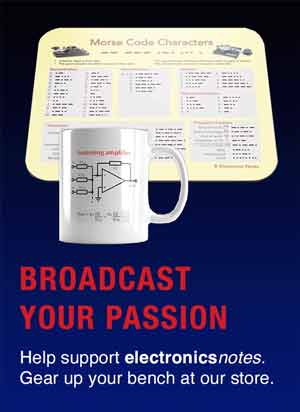Active vs. Passive RF Mixers: Weighing the Trade-offs in Frequency Conversion
One of the main choices to make when selecting an RF mixer (frequency mixer ) for a design is whether to use an active or passive type: I look at the differences, their advantages & disadvantages.
Home » Radio & RF technology » this page
RF Mixers & Mixing Tutorial Includes:
RF mixing basics
Theory & math
Specs & data
How to buy select mixer
Single balanced mixer
Double balanced mixer
Triple balanced mixer
Active vs passive mixers
Mixer circuits:
Transistor mixer
FET mixer
Gilbert cell mixer
Image reject mixer
Mixer components:
RF mixer component data, distributor stock & pricing
In the interesting and challenging world of RF design, the RF mixer, also known as a frequency mixer or frequency converter, is one of the important fundamental building blocks.
The implementation of its non-linear function gives rise to two primary categories of RF mixers: passive mixers and active mixers.

Each approach uses different circuit topologies and each offers a unique set of advantages and disadvantages, making the choice between them a critical design decision dictated by the specific requirements of the application.
This article delves into a comprehensive comparison of active and passive RF mixers, exploring their underlying principles, performance characteristics, and the trade-offs that engineers must carefully consider.
What are active and passive frequency mixers?
It is worth understand what active and passive mixers are and their differences befor looking into their relative advantages and disadvantages.
Passive mixers: Passive RF or frequency mixers, rely on passive non-linear elements within their circuits. Diodes and especially Schottky diodes are normally used. This results in conversion loss, i.e. loss between the input and output but they need no DC power.
There are obviously many types of passive mixer circuit, but where high performance is needed a form of circuit called a double balanced mixer is often used and this incorporates a ring of diodes as shown below.
A typical double balanced passive mixer circuit Active RF mixers: Active RF mixers use active components like transistors to perform frequency conversion, often providing conversion gain and requiring DC power. Passive RF mixers, on the other hand, rely on passive non-linear elements like diodes, resulting in conversion loss and needing no DC power.
When comparing active and passive mixers, it is important to note that it is difficult to give exact comparisons, because a high performance active mixer will outperform a poor passive one, even where, for example the passive one is supposed to be better.
Care must be taken when comparing the two types, but the summaries give a general indication of the comparisons between the two types so that a general idea of what to be aware of can be gained.
The comparisons are for typical high quality passive double balanced mixers and high performance active mixers.
Passive RF Mixers
Passive RF mixers, use passive non-linear components as their key components to achieve frequency conversion.
The most common non-linear element in passive mixers is the diode, typically arranged in configurations such as single-diode, double-balanced, and triple-balanced mixers.
Other passive components like transformers and inductors play crucial roles in impedance matching, signal routing, and spurious signal suppression.
As with any component, it is possible to obtain low end items, but when the high performance ones are used, it is possible to gain the best specifications.
Key characteristics and advantages of top performance passive RF mixers can be summarised but the advantages, etc will depend significantly on the actual mixer and they may have very different characteristics dependent upon the design, type, etc.
High linearity and input IP3 achievable: High quality passive mixers generally exhibit superior linearity compared to their active counterparts. This translates to a higher Third-Order Intercept Point (IP3), indicating a greater ability to handle large input signals without generating significant levels of third-order intermodulation distortion (IMD3). High linearity is paramount in applications where strong adjacent channel signals are present, as it minimizes the generation of in-band distortion products that can mask the desired signal.
High Input Power Handling Capability: Due to the nature of the passive components like diodes and transformers, passive mixers can often handle higher input power levels without damage or significant performance degradation.
This makes them suitable for applications where strong RF signals are encountered.
Excellent Intermodulation Performance: The inherent linearity of passive mixers leads to excellent intermodulation performance, characterized by low levels of IMD products. This is crucial in communication systems where multiple carriers or signals are present within the same frequency band.
No DC Power Consumption: As they rely solely on passive components, passive mixers require no external DC power for their operation. This is a significant advantage in power-sensitive applications, such as battery-powered devices and remote sensing equipment.
Wideband Operation: Many passive mixer designs, particularly those employing broadband transformers, can offer relatively wide operating frequency ranges, providing flexibility in various applications.
Simplicity and Robustness: The relatively simple circuitry of passive mixers often translates to greater robustness and reliability. With fewer components, there are fewer potential points of failure.
It should also be remembered that there are some disadvantages to passive mixers:
Conversion Loss: A primary drawback of passive mixers is their inherent conversion loss. The power of the desired output signal is typically lower than the power of the input RF signal. This loss needs to be compensated for by subsequent amplification stages, which can increase system noise figure and power consumption. Often the conversion loss for ampassive double balanced is around 4.5 to 7dB depending upon the actual device, and of course this impacts the noise figure if it is being used in the front end of a receiving system.
LO Power Requirements: Passive mixers, especially those with multiple diodes like double-balanced and triple-balanced designs, normally require a relatively high LO power to switch the diodes effectively and achieve optimal performance. Figures of +7dBm and +17dBm are common, but other levels are also available.
Isolation Challenges: Achieving good isolation between the RF, LO, and IF ports can be challenging in passive mixers, particularly at higher frequencies. Leakage of the LO signal to the RF or IF ports can cause unwanted interference and spurious responses.
Impedance Matching Sensitivity: The performance of passive mixers can be sensitive to impedance mismatches at the input and output ports, requiring careful impedance matching networks to minimize reflections and optimize power transfer. Often resistive attenuators are used to provide a wideband non-reactive and relatively accurate match, although this does reduce the input, e.g. local oscillator input requiring a high input level. Attentaor values of a few dB will give a much improved impedance match.
Active RF Mixers
Active RF mixers use active devices such as bipolar junction transistors,field-effect transistors, and other forms of active semiconductor device, to perform frequency conversion.
These transistors are biased and configured to provide both the non-linear mixing function and inherent gain.

Active mixers are rather different to passive ones in a number of ways and they have their own set of advantages. It should be remembered that this will depend significantly on the actual mixer and they may have very different characteristics dependent upon the design, type, etc.
Conversion Gain: The most significant advantage of active mixers is their ability to provide conversion gain. The power of the desired output signal can be higher than the power of the input RF signal, eliminating the need for subsequent amplification stages in some applications and improving the overall system noise figure.
Lower LO Power Requirements: Active mixers usually require significantly lower LO power compared to passive mixers, simplifying the LO generation circuitry.
Improved Isolation: Active mixers can often achieve better isolation between the RF, LO, and IF ports due to the inherent isolation provided by the active devices and careful circuit design. This reduces the leakage of unwanted signals and improves overall system performance.
Integration Capabilities: Active mixers are readily integrated into monolithic microwave integrated circuits (MMICs), leading to smaller, lower-cost, and more reliable solutions. This is particularly advantageous in high-volume applications. Some really high performance frequency mixers contained within an IC can be obtained.
Active RF mixers / frequency mixers also have their limitations and disadvantages.
Lower Linearity and Lower Input IP3: Active mixers sometimes exhibit lower linearity compared to passive mixers, resulting in a lower IP3. This makes them more susceptible to generating intermodulation distortion when handling large input signals.
Lower Input Power Handling Capability: Active devices may have limited power handling capabilities compared to passive diodes and transformers. Exceeding the maximum input power can lead to distortion, performance degradation, or even device damage.
Higher DC Power Consumption: Active mixers require DC power to bias the transistors, leading to higher overall power consumption compared to passive mixers. This can be a significant drawback in power-constrained applications.
Higher Noise Figure: Active devices inherently introduce noise into the signal path, and this can result in higher noise figure levels. It is a balance between the noise introduced by the active mixer against the conversion loss of a passive mixer which will cause the NF to be degraded by the conversion loss figure.
Comparison Across Key Performance Parameters
It often helps to compare the various parameters for active and passive mixers within a tabulated format. This gives a quick and easy and more visual summary of the various parameters.
Again it is worth noting that the comparisons are for high quality double balanced passive mixers and high end active mixers.
| Parameter | Passive Mixers | Active Mixers |
|---|---|---|
| Conversion Gain/Loss | Conversion loss (often 4.5 - 7dB) | Typically conversion gain |
| Input IP3 | Usually high | Can be lower |
| Input Power Handling | Often higher | Lower |
| LO Power Requirement | Higher | Lower |
| DC Power Consumption | Zero | Higher |
| Noise Figure | Typically Lower | Typically Higher |
| Isolation (RF-LO, etc.) | Can be Challenging | Generally Better |
| Linearity | Excellent | May not be as good as passive mixer |
| Intermodulation Performance | Excellent | Good to Moderate |
| Complexity | Relatively Simple | More complex but IC technology overcomes this |
| Integration into an IC | Not Easily Integrated | Easily Integrated |
 Written by Ian Poole .
Written by Ian Poole .
Experienced electronics engineer and author.
More Essential Radio Topics:
Radio Signals
Modulation types & techniques
Amplitude modulation
Frequency modulation
OFDM
RF mixing
Phase locked loops
Frequency synthesizers
Passive intermodulation
RF attenuators
RF filters
RF circulator
Radio receiver types
Superhet radio
Receiver selectivity
Receiver sensitivity
Receiver strong signal handling
Receiver dynamic range
Return to Radio topics menu . . .





